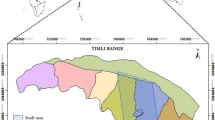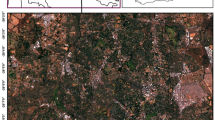Abstract
According to the “Habitat” Directive 92/43/EEC, the conservation status of natural habitats depends on the occurrence of populations of their typical species. For some forest habitats, typical species do not occur as canopy dominant trees but are found in the understory. This is the case with the priority habitat ’‘Apennine beech forests with Taxus and Ilex’’ 9210*. Taxus baccata L. and Ilex aquifolium L. are evergreen tree species and occur as isolated trees or groups in the understory of beech dominated forests. Accordingly, the knowledge of the spatial pattern of populations of typical species is fundamental for habitat monitoring goals. In this perspective, this study aims to evaluate the potential of very high-resolution, true color, leaf-off imagery (pixel size = 0.11 m), supplied by Google Earth, for mapping these populations. Understory layer detection has been accomplished through an object-oriented approach, based on multiresolution segmentation. The classification was developed with thresholds based on spectral and geometric properties, as well as on textural and contextual information. The main critical issues are represented by site conditions, where shadowing can prevent crown detection. The thematic accuracy of the target species map resulted in a Producer Accuracy of 0.77 and a User Accuracy of 0.80. The proposed procedure offers a good methodological foundation with which to map the actual spatial extent of forest broadleaved deciduous habitat types, characterized by low abundance and patchily distributed populations of yew and holly.






Similar content being viewed by others
Notes
‘Community interest’: lists of species and habitats rare, endemic, vulnerable, endangered and strictly protected [Article 1 (g) Habitats Directive].
Priority habitat: “means natural habitat types in danger of disappearance” (Article 1 & d Habitats Directive).
References
Abrahamson IL, Nelson CR, Affleck DLR (2011) Assessing the performance of sampling designs for measuring the abundance of understory plants. Ecol Appl 21:452–464. https://doi.org/10.1890/09-2296.1
Aher M, Pradhan S, Dandawate Y (2014) Rainfall estimation over roof-top using land-cover classification of google earth images. Proc-Int Conf Electron Syst Signal Process Comput Technol ICESC 2014:111–116. https://doi.org/10.1109/ICESC.2014.24
Alberdi I, Nunes L, Kovac M et al (2019) The conservation status assessment of Natura 2000 forest habitats in Europe: capabilities, potentials and challenges of national forest inventories data. Ann For Sci. https://doi.org/10.1007/s13595-019-0820-4
Alleaume S, Dusseux P, Thierion V et al (2018) A generic remote sensing approach to derive operational essential biodiversity variables (EBVs) for conservation planning. Methods Ecol Evol 9:1822–1836. https://doi.org/10.1111/2041-210X.13033
Almeer MH (2012) Vegetation extraction from free google earth images of deserts using a robust BPNN approach in HSV space. Int J Adv Res Comput Commun Eng 1:134–140
Baatz M (1999) Object-oriented and multi-scale image analysis in semantic networks. In: Proceedings the 2nd International Symposium on Operationalization of Remote Sensing, Enschede, ITC, Aug 1999
Baatz M (2000) Multi resolution segmentation: an optimum approach for high quality multi scale image segmentation. In: Beutrage zum AGIT-Symposium. Salzburg, Heidelberg, 2000. pp 12–23
Baatz M, Heynen M, Hofmann P et al (2001) eCognition User Guide 2.0: Object oriented image analysis. Defin Imaging GmbH, Munich, Ger 427
Bartels SF, Chen HYH (2013) Interactions between overstorey and understorey vegetation along an overstorey compositional gradient. J Veg Sci 24:543–552. https://doi.org/10.1111/j.1654-1103.2012.01479.x
Benham SE, Houston Durrant T, Caudullo G, de Rigo D (2016) Taxus baccata in Europe: distribution, habitat, usage and threats. Eur Atlas For Tree Species e015921+
Borre JV, Paelinckx D, Mücher CA et al (2011) Integrating remote sensing in Natura 2000 habitat monitoring: prospects on the way forward. J Nat Conserv 19:116–125
Corbane C, Deshayes M (2000) Possibilities and limits of remote sensing for mapping natural habitats. Lit Rev Montpellier Inst Natl Rech en Sci Technol pour l’Environnement l’Agriculture (IRSTEA) FP7 Proj MSMONINA-Multi-scale Serv Monit Nat 2–3
Corbane C, Lang S, Pipkins K et al (2015) Remote sensing for mapping natural habitats and their conservation status—New opportunities and challenges. Int J Appl Earth Obs Geoinf 37:7–16. https://doi.org/10.1016/j.jag.2014.11.005
Curtin KM, Voicu G, Rice MT, Stefanidis A (2014) A comparative analysis of traveling salesman solutions from geographic information systems. Trans GIS 18:286–301. https://doi.org/10.1111/tgis.12045
Drǎguţ L, Tiede D, Levick SR (2010) ESP: a tool to estimate scale parameter for multiresolution image segmentation of remotely sensed data. Int J Geogr Inf Sci 24:859–871. https://doi.org/10.1080/13658810903174803
Dubreuil M, Riba M, González-Martínez SC et al (2010) Genetic effects of chronic habitat fragmentation revisited: Strong genetic structure in a temperate tree, Taxus baccata (Taxaceae), with great dispersal capability. Am J Bot 97:303–310. https://doi.org/10.3732/ajb.0900148
Duhl TR, Guenther A, Helmig D (2012) Estimating urban vegetation cover fraction using Google Earth® images. J Land Use Sci 7:311–329. https://doi.org/10.1080/1747423X.2011.587207
El-naggar AM (2018) Determination of optimum segmentation parameter values for extracting building from remote sensing images. Alex Eng J 57:3089–3097. https://doi.org/10.1016/j.aej.2018.10.001
European Union (1992) Council directive 92/43/EEC of 21 May 1992. Off J Eur Commun 35:7–51
European Commission DE (2007) Interpretation manual of European Union habitats. Eur Comm Environ Eur 27
Evans D (2006) The habitats of the European Union habitats directive. In: Biology and Environment: Proceedings of the Royal Irish Academy. JSTOR, pp 167–173
Finegold Y, Ortmann A, Lindquist E et al (2016) Map accuracy assessment and area estimation map accuracy assessment and area estimation: a practical guide. Food Agric Organ United Nations Natl For Monit Assess Work Pap 46:69
Hijmans RJ, Elith J (2013) Species distribution modeling with R. R Packag version 8–11
Hu Q, Wu W, Xia T et al (2013) Exploring the use of google earth imagery and object-based methods in land use/cover mapping. Remote Sens 5:6026–6042. https://doi.org/10.3390/rs5116026
Hunt ER Jr, Doraiswamy PC, McMurtrey JE et al (2013) A visible band index for remote sensing leaf chlorophyll content at the canopy scale. Int J Appl Earth Obs Geoinf 21:103–112
Immitzer M, Atzberger C, Koukal T (2012) Tree species classification with random forest using very high spatial resolution 8-band worldView-2 satellite data. Remote Sens 4:2661–2693. https://doi.org/10.3390/rs4092661
Lang S, Mairota P, Pernkopf L, Schioppa EP (2015) Earth observation for habitat mapping and biodiversity monitoring. Int J Appl Earth Obs Geoinf 37:1–6
Lengyel S, Déri E, Varga Z et al (2008) Habitat monitoring in Europe: a description of current practices. Biodivers Conserv 17:3327–3339
Li Y, He J, Yu S et al (2019) Spatial structure of the vertical layers in a subtropical secondary forest 57 years after clear-cutting. IForest 12:442–450. https://doi.org/10.3832/ifor2975-012
Lucas R, Medcalf K, Brown A et al (2011) Updating the phase 1 habitat map of Wales, UK, using satellite sensor data. ISPRS J Photogramm Remote Sens 66:81–102
Ludwig A, Meyer H, Nauss T (2016) Automatic classification of google earth images for a larger scale monitoring of bush encroachment in South Africa. Int J Appl earth Obs Geoinf 50:89–94
Marchetti F, Waske B, Arbelo M et al (2019) Mapping Chestnut stands using bi-temporal VHR data. Remote Sens 11:1–19. https://doi.org/10.3390/rs11212560
McComb B, Zuckerberg B, Vesely D, Jordan C (2010) Monitoring animal populations and their habitats: a practitioner’s guide. CRC Press, Boca Raton
Monkkonen P (2008) Using online satellite imagery as a research tool: mapping changing patterns of urbanization in Mexico. J Plan Educ Res 28:225–236
Mustafa YT, Habeeb HN (2014) Object based technique for delineating and mapping 15 tree species using VHR WorldView-2 imagery. In: Remote Sensing for Agriculture, Ecosystems, and Hydrology XVI. International Society for Optics and Photonics, Bellingham, p. 92390G
Nagendra H (2001) Using remote sensing to assess biodiversity. Int J Remote Sens 22:2377–2400
Pontius RG (2000) Quantification error versus location error in comparison of categorical maps. Photogramm Eng Remote Sens 66:1011–1016
Pontius RG Jr, Lippitt CD (2006) Can error explain map differences over time? Cartogr Geogr Inf Sci 33:159–171
Rocchini D, Hernández-Stefanoni JL, He KS (2015) Advancing species diversity estimate by remotely sensed proxies: a conceptual review. Ecol Inform 25:22–28
Rosenfield GH, Fitzpatrick-Lins K (1986) A coefficient of agreement as a measure of thematic classification accuracy. Photogramm Eng Remote Sens 52:223–227
Stehman SV, Czaplewski RL (1998) Design and analysis for thematic map accuracy assessment: fundamental principles. Remote Sens Environ 64:331–344
Thomas PA (2015) Response of European yews to climate change: a review. For Syst. https://doi.org/10.5424/fs/2015243-07465
Tittensor RM (1980) Ecological history of yew Taxus baccata L. in southern England. Biol Conserv 17:243–265
Urbinati C, Iorio G (2016) Habitat reali o virtuali? Commenti a “Manuali per il monitoraggio di specie e habitat di interesse comunitario (Direttiva 92/43/CEE) in Italia: habitat.” For Silv For Ecol 13:59
Yu L, Gong P (2012) Google earth as a virtual globe tool for earth science applications at the global scale: progress and perspectives. Int J Remote Sens 33:3966–3986
Online document
European Environment Agency (2020) Habitat Annex I Directive. Apennine beech forests with Taxus and Ilex. https://eunis.eea.europa.eu/habitats/10206. Accessed 31 Mar 2020
Book
Newton A (2007) Forest ecology and conservation: a handbook of techniques. Oxford University Press, Oxford
Brown J (2014) Adaptive sampling methods. Manly BF. CRC Press, Boca Raton, Alberto JA, pp 33–46
Acknowledgements
This research was supported by the project “FRESh LIFE Demonstrating Remote Sensing integration in sustainable forest management” (LIFE14 ENV/IT/000414).
Author information
Authors and Affiliations
Contributions
DG conceived the study with AB. DG and AB devised the sampling design. LO, DG and FM collected field data. DG performed image segmentation, classification and accuracy assessment. LO wrote the manuscript with support from AB and DG. All authors read and approved the final manuscript.
Corresponding author
Ethics declarations
Conflict of interest
The authors declare no conflicts of interest.
Additional information
Communicated by Corrado Marcenò.
Publisher's Note
Springer Nature remains neutral with regard to jurisdictional claims in published maps and institutional affiliations.
This article belongs to the Topical Collection: Forest and plantation biodiversity.
Rights and permissions
About this article
Cite this article
Oreti, L., Barbati, A., Marini, F. et al. Very high-resolution true color leaf-off imagery for mapping Taxus baccata L. and Ilex aquifolium L. understory population. Biodivers Conserv 29, 2605–2622 (2020). https://doi.org/10.1007/s10531-020-01991-x
Received:
Revised:
Accepted:
Published:
Issue Date:
DOI: https://doi.org/10.1007/s10531-020-01991-x




